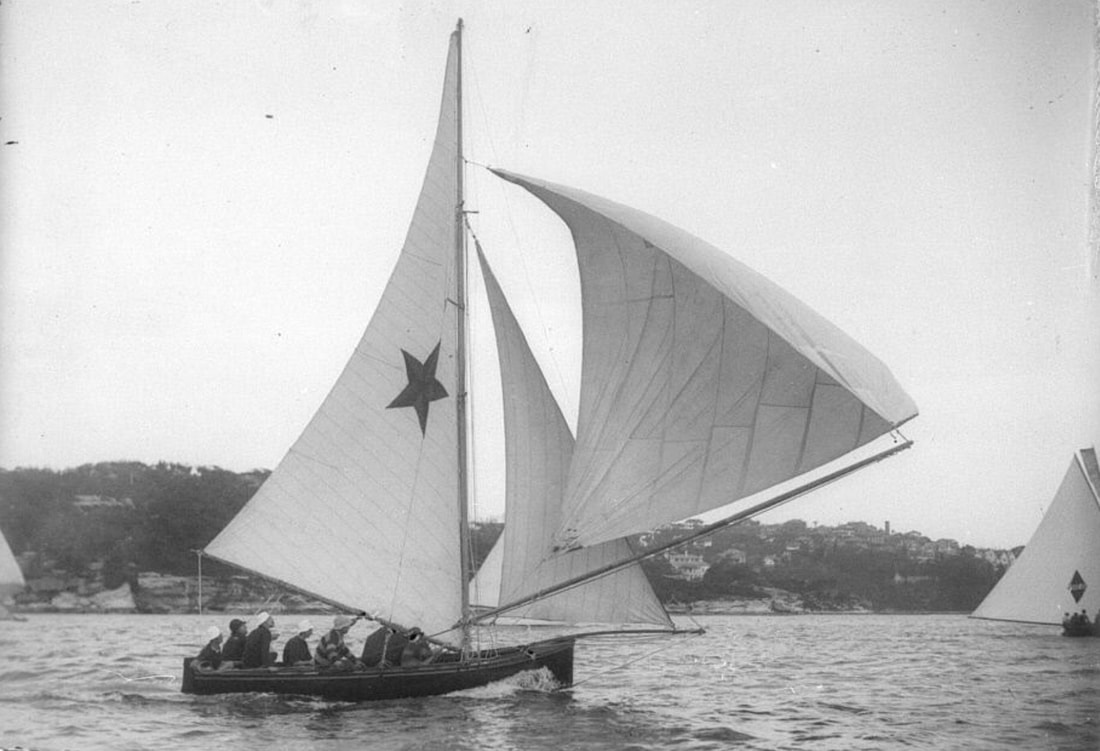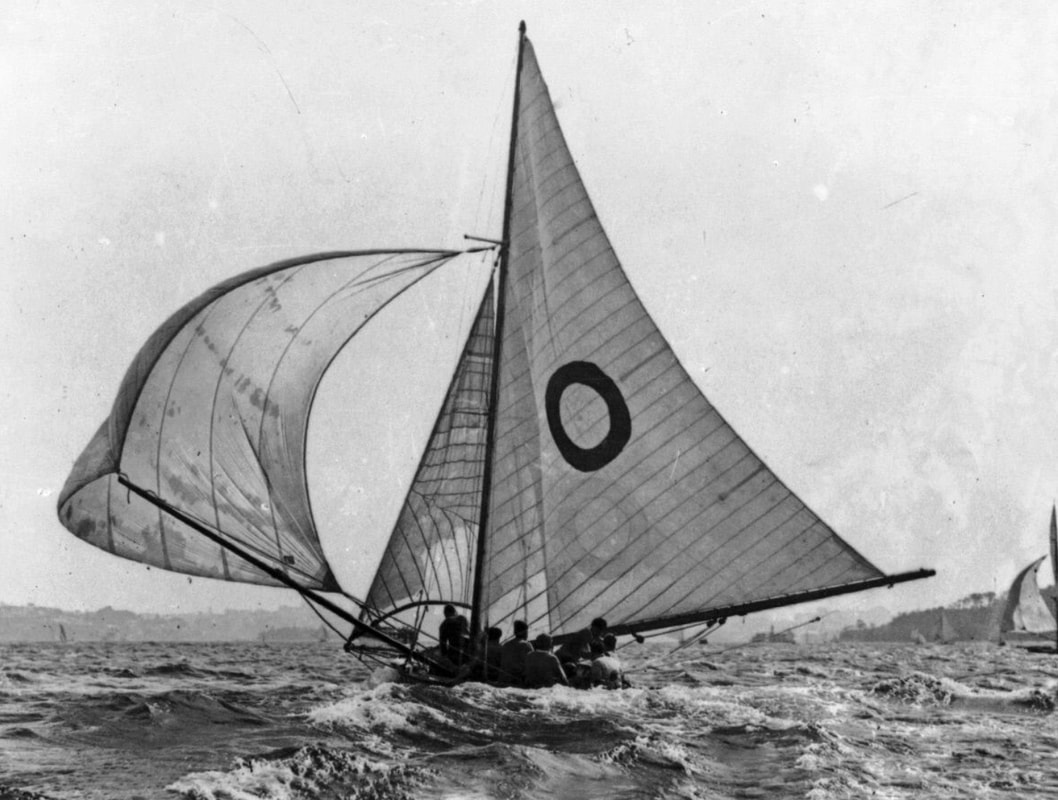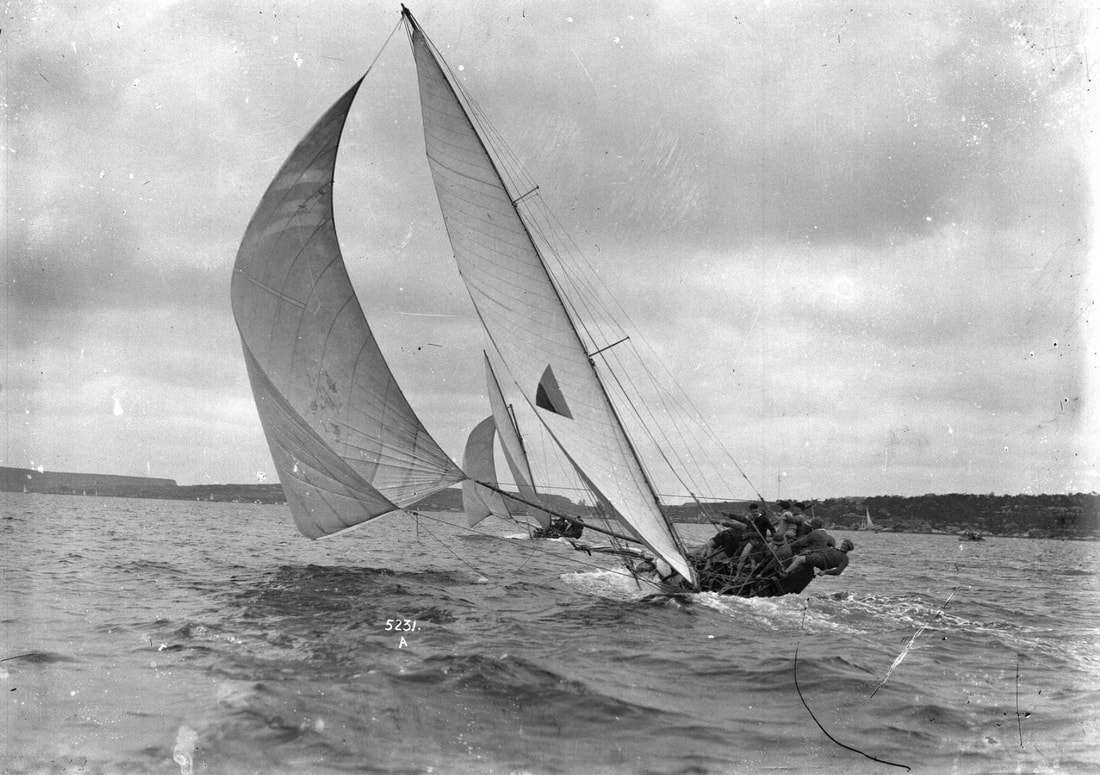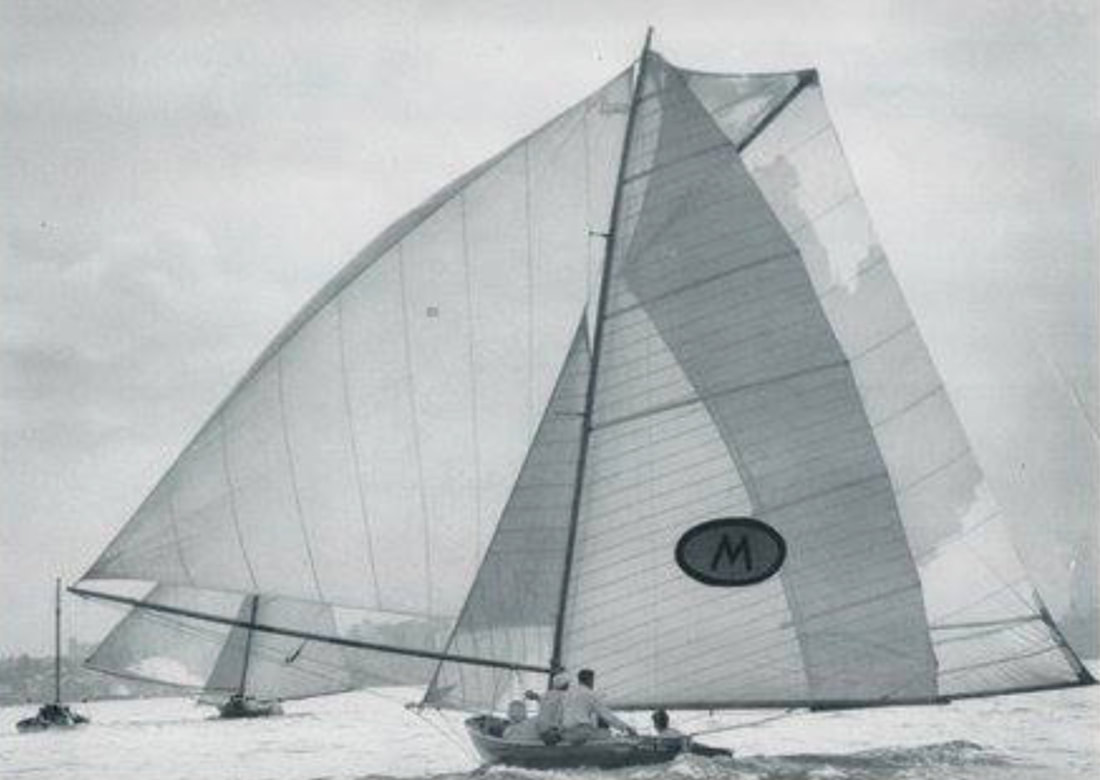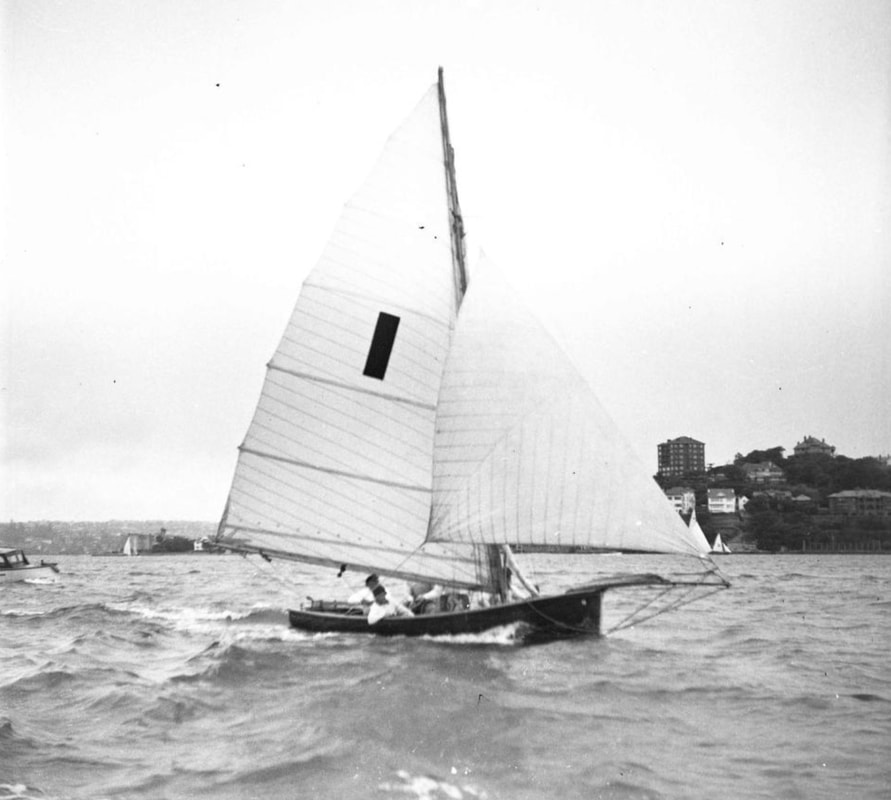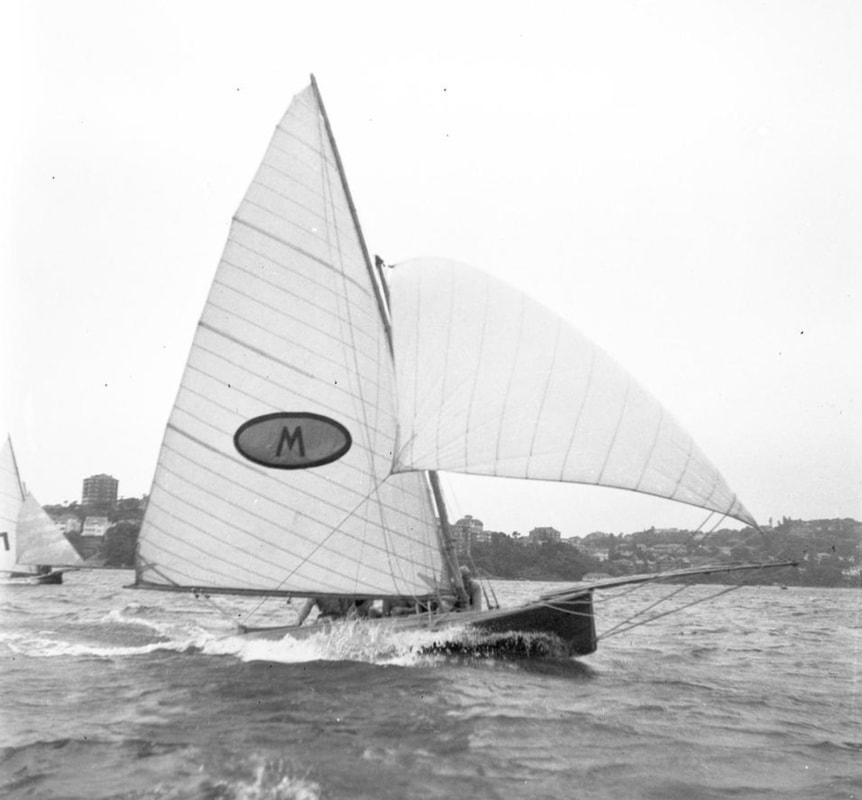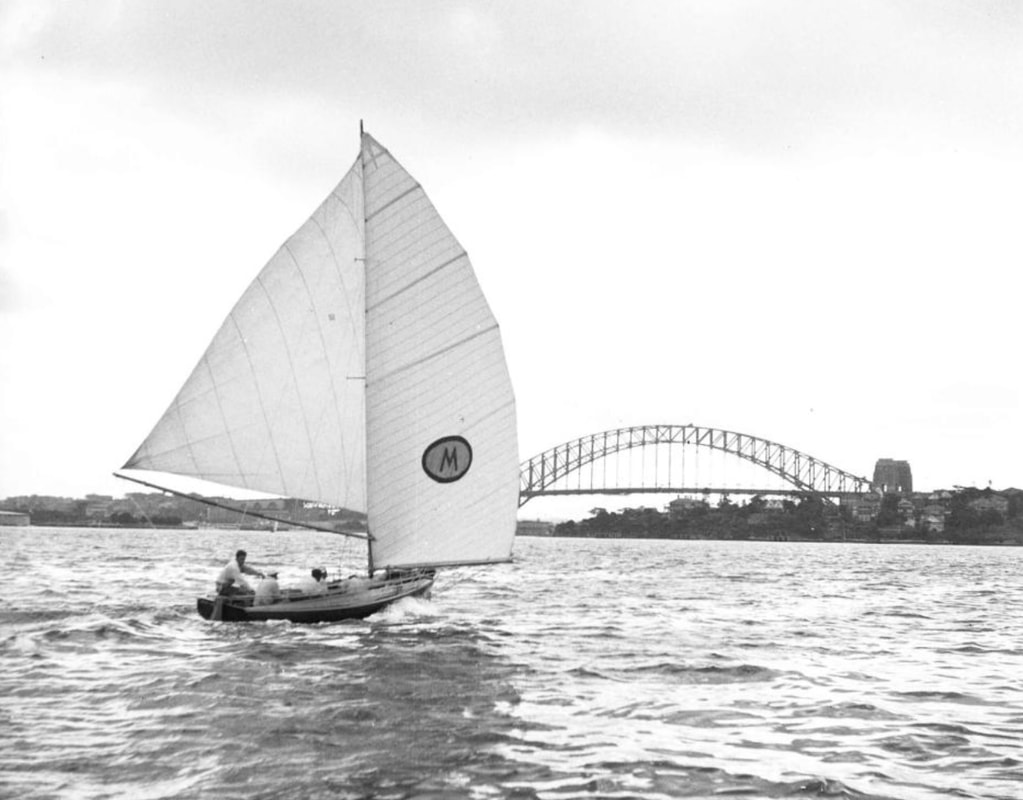Bermudan rig featuring triangular mains’ls began to appear on British racing yachts as early as 1912 when the J-class yachts began to exhibit was than then called Marconi rig because the large number of extra stays on the tall masts reminded people of Marconi radio masts. Most racing fleets including yachts in Australia began to follow suit. It was seen as inevitable progress by most yachtsmen, but not everyone was convinced. Sydney yachting legend Bill Gale tells the story that when his father Cliff Gale had Bill Fisher build him a yacht to Cliff’s design he named Ranger he designed a simple lug rig for it, but changed it a few years later to gaff rig. He was told that it would be better if he’d fitted it with a Bermudan rig, that it would never point and would be slower upwind. Ranger is still racing on Sydney Harbour under gaff rig and often beats larger more modern boats boat for boat. A near-sister ship Cherub was converted to Bermudan (or Bermudian as Bill Gale still insists) in the 1950’s but it was not until it was converted back to gaff rig in the early 2000’s that Cherub became competitive with Ranger again.
Caledonia, the first 18-footer to experiment with Bermudan rig,1922. The boat was not particularly successful. Photo ANMM Hall Collection.
Sydney’s open boat sailors were also hard to be convinced of the benefits of Bermudan rig. But as in any racing fleet there is always someone who will try something new. In 1922 Mr Horace Rodrick had C Blackford build him an 18-footer to a novel design by Rodrick’s brother (who had been in the crew of Irex on the Medway in 1898, see another YARN: THE ANGLO-AUSTRALIAN SHIELD) which featured two centreboards, one in the normal position and one aft, but more importantly was Marconi-rigged. The mast was 34’ tall, at a time when the biggest gaff-rigged mast was about 30’. The first race of this boat on 18 February 1922 was highly anticipated and they managed fifth place in a handicap race off scratch, not a bad effort. It was described as having “quaint gear”. However Caledonia was only able to manage one more minor place during the rest of that season, and the Bermudan rig was seen as a failed experiment. Caledonia was fitted with a new gaff-rigged main at the beginning of the following season. This seemed to make very little difference and the boat was retired after about 5 or 6 seasons.
Arawatta was the next boat to try it, being fitted with a Bermudan rig in 1930. The one pictured has got to be a second or third rig mast for fresh conditions. Photo ANMM Hall Collection.
The next boat to try a triangular mains’l was Arawatta, built by Charlie Hayes for James Watt the SFS Commodore in 1927. Arawatta used conventional gaff rig for the first few seasons and raced quite successfully, being mostly on or near scratch and winning the Port Jackson Championship in 1928. In January 1930 she was given a 40’ (also described as 46’6” and 48’!) hollow Marconi mast and a Bermudan mains’l. She had featured in enough races to remain on or close to scratch and was selected to represent NSW in Brisbane for the Australian Championships in late January 1930 but capsized in the race. But the following year in Sydney she won the Australian Championship.
Arawatta with one of her big Bermudan rigs. This mast was variously reported at between 40' and 52'6". I suspect that forty-something would be most likely. Note the double spreaders. They broke the Bermudan masts several times. Arawatta changed her sail insignia from a blue circle to a red and blue pennant sometime in 1931 or 1932, but James Watt remained the owner. Photo ANMM Hall Collection.
The next season the Championship was in Brisbane and Arawatta broke her mast, which was variously described as 48’ and 52’6” tall, but I would suggest that the previously mentioned 40-46’6” was more likely. Arawatta won the Championship again in 1932-33 in Sydney with the Bermudan rig, but regular capsizes and mast problems led them to go back to gaff rig in February 1933. The 18-footer movement consensus was that Bermudan rig was an experiment not worth repeating.
Another shot of Arawatta's big Bermudan rig. Even though she won the Australian Championship twice, numerous mast breakages and capsizes convinced Watt to go back to gaff rig in 1933. Photo Sydney Flying Squadron Collection.
After the split that led to 2 clubs from 1935, the new League had narrower, lighter and faster boats than the Squadron with high-peaked battened gaff rigs copied from those that the 16-foot skiffs had been using since the early 1900’s. After the Second World War the Squadron adopted even narrower boats, of 6’ beam, still carrying the skiff-type gaff rigs. Bill Barnett’s Myra Too became the winner of a triple crown being NSW, Australian and World Champion in 1950, with a gaff second rig but a Bermudan big rig. Myra Too so dominated 18-footer racing that season that other boats began to copy her and within a few seasons gaff rig had disappeared from 18-footers. The 16-foot skiffs were a little longer in adopting triangular mains, some 16’s were still carrying gaff rigs in the late 1950’s.
Bill Barnett and Myra Too's success in 1950 with a smaller, lighter boat finally convinced 18-footer sailors that Bermudan rig was the way to go. They still carried ringtails for a few more seasons. Photo ANMM Hall Collection.
One of the perceived main advantages of Bermudan rig was that yachts could have a permanent backstay and eliminate runners, but this was never the case on 18-footers. Caledonia’s and Arawatta’s booms were still too long to allow for permanent back stays. Eighteen-footer gaff rigs were always higher-peaked than contemporary yacht rigs, and after the skiff-type rigs came into general use after 1935 they were higher-peaked still (often being referred to as Gunter rigs, a reworking of a term for a telescopic rig popular in the 1850’s). These factors probably contributed to the long cling to gaff rig, but the main reason was because the few attempts made to carry Bermudan rigs were not successful. Only when Bill Barnett began to dominate the fleet with his Bermudan rig did it finally convince everyone that Bermudan was the way to go.
Update March 2022: I correspond regularly with Galloping Ghosts author Robin Elliott, and he sent these comments on the above yarn. His comments are correct, I had not paid enough attention to the New Zealand influence on the conversion to Bermudan rig, and I had not acknowledged Lance Watts’ contribution from Queensland.
The kiwis in the four competitions against the Aussie 18’s in 1938, 1939, 1948 and 1949 all had Bermudan rigged boats on their team. Not much was made of this as they didn’t do any real damage to the Sydney egos, certainly not on Sydney Harbour which is where it all counted and where the money was. Only when the gaff boats began to get regularly beaten did the penny begin to drop but a lot had to happen first (e.g. a World War). After the war, there were no serious NZ 18’s built with gaff rig so development of the Bermudan rig on an 18 began a bit sooner than in Oz.
The kiwis in the four competitions against the Aussie 18’s in 1938, 1939, 1948 and 1949 all had Bermudan rigged boats on their team. Not much was made of this as they didn’t do any real damage to the Sydney egos, certainly not on Sydney Harbour which is where it all counted and where the money was. Only when the gaff boats began to get regularly beaten did the penny begin to drop but a lot had to happen first (e.g. a World War). After the war, there were no serious NZ 18’s built with gaff rig so development of the Bermudan rig on an 18 began a bit sooner than in Oz.
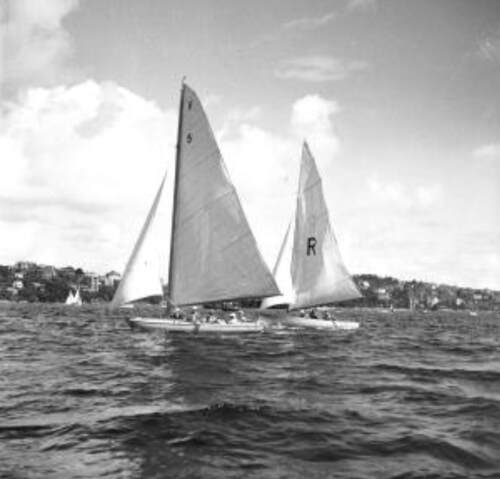
New Zealand 18’s Tarua and Result on Sydney Harbour in 1951. ANMM Hall Collection
Post-war, several builders were already going down the ‘small is better’ route. In Auckland Howard Pascoe’s Result, launched in 1949 was an all-inboard rig and really a blown up International 14. She was really successful for such a small boat. Over in Brisbane Lance Watt’s champion Culex III, also launched in 1949 followed a very similar line of thought. She won the 1950 Interstate and Bill Barnett would have taken note (see photo of them next to each other in Galloping Ghosts p 130 ).
Marconi rigged Takiri from NZ was 3rd in the 1949 JJG in Sydney. In the 1950 JJG in Auckland, the cream of the League’s fleet, Alruth, Sea Witch, Irene Too and Shamrock III were utterly destroyed by Jack Logan’s bermudan rigged skimmer Komutu, a result that caused a lot of soul searching at the League. Billy Barnett’s Myra had already petrified them and Myra II was worse. In the 1951 JJG Logan’s follow-up skimmer Tarua came second to Myra II in Sydney. Mander’s Intrigue (the gadget boat) won in Suva 1952 with Tarua 2nd. So bermudan rigged boats had won 3 Giltinans on the trot and came second in two of them.
In the 1950 Australian Champs Culex III won. In the 1951 champs Myra II won with Culex III 2nd. 1952 was Jenny IV, Myra III second, all bermudan rigged boats. Billy Barnett however (along with Heffo) being from the despised SFS, did the most damage to the League and pretty soon (reluctantly) smaller and lighter hulls, Bermudan rigged, became the norm as the League played catch-up.
Marconi rigged Takiri from NZ was 3rd in the 1949 JJG in Sydney. In the 1950 JJG in Auckland, the cream of the League’s fleet, Alruth, Sea Witch, Irene Too and Shamrock III were utterly destroyed by Jack Logan’s bermudan rigged skimmer Komutu, a result that caused a lot of soul searching at the League. Billy Barnett’s Myra had already petrified them and Myra II was worse. In the 1951 JJG Logan’s follow-up skimmer Tarua came second to Myra II in Sydney. Mander’s Intrigue (the gadget boat) won in Suva 1952 with Tarua 2nd. So bermudan rigged boats had won 3 Giltinans on the trot and came second in two of them.
In the 1950 Australian Champs Culex III won. In the 1951 champs Myra II won with Culex III 2nd. 1952 was Jenny IV, Myra III second, all bermudan rigged boats. Billy Barnett however (along with Heffo) being from the despised SFS, did the most damage to the League and pretty soon (reluctantly) smaller and lighter hulls, Bermudan rigged, became the norm as the League played catch-up.
Lance Watts’ Culex III on Sydney Harbour in 1951. ANMM Hall Collection.
I’m guessing here but I think the gaff/Bermudan thing on the older Aussie 18’s was a power to weight problem, one of engineering. Those hulls were so heavy that in order to get the enormous power to move the buggers (ringtails topsails peak headers etc etc) you just couldn’t do it with a Bermudan rig. Going tall like Arawatta and Caledonia just gave you a different problem. Staying such a tall mast became a nightmare hence all the broken spars. Looked fantastic and takes a dramatic photograph but utterly unreliable – and expensive.
Only when you substantially reduce the hull weight can you get an efficient and effective tall Bermudan rig on an 18 such as Komutu, Myra II. By 1952 The kiwis went another stage further and made the hulls ultra-light (see Daniel Boone p157 in Galloping Ghosts). This created other problems in that they could not stand upright unattended. Much like the older 18’s, the kiwi rigs were quite low aspect with the sail pushed out on the bowsprit and main boom, but the gains were made in the weight-saving and the use of the trapeze allowed mast height to increase slightly and to overcome their inherent instability. Kiwi 18s won the JJG in 1950, 1952 and 1954 in Bermudan rigged boats. Myra II won in 1951, there was no competition in 1953 due to the Suva event being run during our winter.
I think the direction Lance Watts took with his small Culex hulls culminating in Bermudan rigged Culex III had an influence on Billy Barnett who would have run across them when he had Jenny Too and his first Myra. Then again, any builder worth his salt read all the latest updates on design and rig from overseas magazines and took any good/interesting ideas accordingly. Hence Howard Pascoe in NZ expanding on his International 14 experience and building Result in 1949 which went down a similar direction to Lance Watts with the all inboard rig, no bumpkin/bowsprit and a smaller crew, all weight saving devices. Result was known to have beaten Jack Logan’s Tarua several times, to local amazement.
The smaller boats were competitive in certain conditions but in a yacht class where SPECTACLE is everything they did not find much encouragement. The advent of the trapeze on the NZ boats in the early 1950’s certainly allowed a small/light hull to cram on some extra sail and still give the punters the thrills and spills they had become accustomed to.
As an aside…
A decade later, Bob Miller’s Taipan went even smaller and, worse still for the old guard, was devastatingly fast and rendered all others obsolete. As a spectacle however the Taipan type 3 –handers were duds and caused much angst here and across the Tasman. In Auckland the crowds that used to flock to Orakei waterfront to watch the 5 and 6-handers just melted away. Only the diehards were left.
-Robin Elliott
Only when you substantially reduce the hull weight can you get an efficient and effective tall Bermudan rig on an 18 such as Komutu, Myra II. By 1952 The kiwis went another stage further and made the hulls ultra-light (see Daniel Boone p157 in Galloping Ghosts). This created other problems in that they could not stand upright unattended. Much like the older 18’s, the kiwi rigs were quite low aspect with the sail pushed out on the bowsprit and main boom, but the gains were made in the weight-saving and the use of the trapeze allowed mast height to increase slightly and to overcome their inherent instability. Kiwi 18s won the JJG in 1950, 1952 and 1954 in Bermudan rigged boats. Myra II won in 1951, there was no competition in 1953 due to the Suva event being run during our winter.
I think the direction Lance Watts took with his small Culex hulls culminating in Bermudan rigged Culex III had an influence on Billy Barnett who would have run across them when he had Jenny Too and his first Myra. Then again, any builder worth his salt read all the latest updates on design and rig from overseas magazines and took any good/interesting ideas accordingly. Hence Howard Pascoe in NZ expanding on his International 14 experience and building Result in 1949 which went down a similar direction to Lance Watts with the all inboard rig, no bumpkin/bowsprit and a smaller crew, all weight saving devices. Result was known to have beaten Jack Logan’s Tarua several times, to local amazement.
The smaller boats were competitive in certain conditions but in a yacht class where SPECTACLE is everything they did not find much encouragement. The advent of the trapeze on the NZ boats in the early 1950’s certainly allowed a small/light hull to cram on some extra sail and still give the punters the thrills and spills they had become accustomed to.
As an aside…
A decade later, Bob Miller’s Taipan went even smaller and, worse still for the old guard, was devastatingly fast and rendered all others obsolete. As a spectacle however the Taipan type 3 –handers were duds and caused much angst here and across the Tasman. In Auckland the crowds that used to flock to Orakei waterfront to watch the 5 and 6-handers just melted away. Only the diehards were left.
-Robin Elliott
Myra Too had a gaff second rig but a Bermudan big rig. Both photos ANMM Hall Collection.
